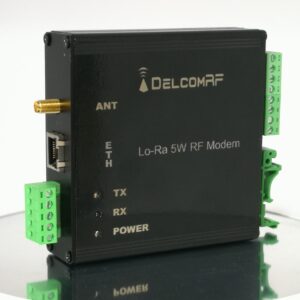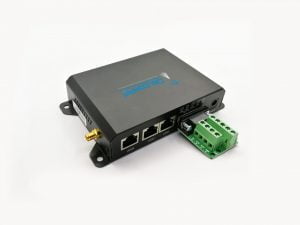Wireless Technologies for Industrial Automation
In this article, I want to talk under the heading of wireless technologies for industrial automation. The main reason for using wireless technologies for industrial automation is due to the cost policy. With 100 mW RF power, it is possible to wirelessly transmit digital or analog data to the receiver 5000 meters away.
This is a sufficient distance in a factory to wirelessly transport sensor information from one point to another. Analogue or digital sensor information, plc data in the factory are transported from one point to another with valuable and high labor costs.
In addition, there is a new labor cost and a new cable cost for additional data or control needs that may occur later. Therefore, the importance of using wireless technologies for industrial automation has become an indisputable reality. But it should be remembered that there is no reality that every wireless communication technology solves every problem. The right products should be chosen for the right applications and should be supported by secure software. The way to do this is through a professional. DelcomRF Wireless Technologies Inc., a manufacturer and implementer of wireless automation systems. It safely carries you to the level you want to reach in wireless automation projects.
The evolution in wireless technologies has opened the door to a new class of automation architecture that provides a significant strategic advantage. Significant and measurable cost savings in engineering, installation and logistics, as well as dramatic improvements in the frequency and reliability of field data collection, as well as cheap and easy-to-use applicability.
Cost advantages are the top priority among those driving the adoption of wireless technologies. Other important considerations are the security and better management of legacy systems that were not on the network before. It can be listed as follows;
Workmanship and Installation:
Working wirelessly in an industrial environment is 10 times cheaper than wired alternatives. It also provides faster commissioning and stability. Engineering costs are also drastically reduced, as extensive research and planning is no longer required to route cables to junction boxes or control rooms.
Reduced costs in cabling engineering, installation and maintenance, combined with increased data collection flexibility, are the driving forces in using wireless technologies.
Instant and Accurate Information:
As a result of replacing manual readings with automatic measurement with an RF wireless system, time-saving clean and clear information can be obtained quickly.
Deployment:
It is much easier to apply detachable and removable systems to the created wireless network. Integration of legacy systems can be easily taken into the same network. You can instantly integrate Modbus-powered RS485 technology into the wireless network with a wireless modbus rf radio modem.
Application Saver:
There are rapid detection of internal problems. The problem can be solved within minutes by changing the wireless data carrier or sensor connected to the system, without the need to follow the data line-wiring for defective sensor or plc and so on. It ensures that the budget allocated for maintenance is reduced.
Having a wireless automation network that can prevent the problems such as manually opening and closing the valve by sending one to the system and having a wireless automation network that can open and close the valve at the desired degree increases the safety of human and life in dangerous production areas.
Unfortunately, one type of wireless technology doesn’t solve all problems. Therefore, in order to maximize the return on their industrial wireless networking investment, companies must choose the most suitable technology for a particular application, not the most expensive. While you have wireless radio modems-networks operating at rs-485 level with modbus communication, saying that Ethernet is a new technology like modbus, it does not make sense to try to equip the facility with expensive technology to earn more money and may cause the company to do more damage than wired technology. .
By evaluating the properties of various wireless technology products, interference decisions should be taken for the successful implementation of the wireless architecture solution. These include features such as the output power of the RF Modbus Radio Modem, data transfer rates, manageability of rf sensor sensitivities.
ISM Frequency Band
FCC and CE notifications have separated different frequency bands into ISM and PMR channels up to a certain power in America and Europe. 902-928 Mhz bands can be used in America and 869 Mhz band in Europe up to 1W and 500mW power, without license. By obtaining a license, you can provide data transfer over very long distances with 5W or higher powers in the frequency band allocated to you.
RF Radio Modems:
Even if it communicates with Modbus RF Radio Modems with high sensor sensitivity with low power, you may be able to communicate over long distances. Companies with application needs for industrial facilities ask a common question for short distance communication; Do point-to-point antennas need to see each other for RF communication? “No” is often the answer. But it is not true, if a rock starts to sink into the water, the speed it reaches when the blie hits the water causes the rock to slow down, and when it hits, a small amount of particle ruptures. This is the case with RF signals, hitting obstacles the lower the signal strength and quality.
The best wireless communication distance and quality is provided by the communication between two antenna points by seeing each other.
Proper antenna use and the ability to adjust RF output power help to overcome these problems and receive messages. Industrial quality, directional and high gain antennas provide wireless data communication over long distances in a crowded industrial facility environment. Low gain antennas can be used to prevent radio signals from straying from unwanted distances or directions.
Modbus Supported Protocol:
In many existing wired networks, the user can use one protocol at a time. By using wireless architecture, it is possible for several protocols to work on the same communication layer, giving the user more flexibility.
It is a great advantage that any device can be wirelessly connected to existing control systems without number limit. Combined with wireless communication that supports this feature, it turns into a much greater advantage. Pwm modbus rf radio modems that support Modbus communication protocol can easily solve this complexity instead of wireless products that consist of a transmitter and receiver and work as a set by making 4-20 mA signal and I / O communication….
Industrial Production:
For products designed for industrial applications, it should use industrial grade components and operate reliably in industrial temperature ranges typically from -40 C to +80 C (-40 F to 185 F). Problems that can arise from extreme temperatures are commonplace in many applications. In addition, these products are generally manufactured better than consumer devices and continue to work reliably “according to certain dimensions” under shock and vibration conditions. DelcomRF Inc. produces products of this status.
Usability Confirmation:
Industrial wireless modems typically carry some form of certification. Most commonly this is CE certification. In addition, these wireless products must be registered on the BTK “Information and Communication Technologies Authority” website, which is the relevant institution, in the list of devices that have been approved with the Class2 notification form, together with the manufacturer name and can be viewed by the person who wants.
Wireless Automation
Wireless control systems have been indispensable for industrial automation. Does it take a silver-plated cable for miles or a plug-and-play kit that transmits wireless sensor information provides more efficient and affordable support? The most usable feature of industrial wireless devices is their compatibility with existing OEM technology.
Security – Wireless communication, environmental alarms and personnel management provide greater security and compliance with OSHA regulations in hazardous environments and locations where the facility is close to residential areas. Systems that can detect intrusion, control access, report smoke or fire provide more performance than wired communication.
Workforce Mobility – Wireless connectivity allows mobile workers to access apps on the go, which can increase productivity. Progressing to fixed panels affects worker mobility and productivity.
Stock and Mobile Tracking – Asset tracking supports better use of assets as well as ensuring legal compliance for the use, storage and transportation of hazardous chemicals.
Integrating Wireless Sensor Networks – Sensor integration represents an emerging technology with great potential for common applications. These networks consist of many simple complexities with limited power resources and functionality, but they benefit more than the sum of that complexity. More flexibility and connectivity can be achieved by integrating these networks with other long-range wireless technologies.
More Efficient Use of Information
Knowledge is power. Therefore, the key to constantly adapting to change, with the ability to collect time-critical information, react back to the situation with rapid analysis, increased reliability and profitability, is to some extent through wireless automation applications. As mentioned, no type of wireless technology solves all problems. For this reason, paying attention to the selection of applications, software and hardware with a professional in order to ensure that the selected wireless architecture maximizes limited resources will carry you forward and prevent waste by targeting the purchase of goods.




